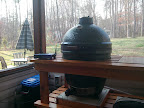Edwin Gonzalez
New member
Bryan,
Since I am currently building the stand-alone version I used the "HeaterMeter software step by step (Windows)" under "Installation of HeaterMeter" in the Wiki. I just uploaded the AVR firmware via the Arduino software, and an Arduino Uno board, with the code provided on the wiki. The hex file would be used to flash the AVR via the web interface (router) right? Since I don't have a working router at the moment, this option isn't available to me so I haven't used any hex files. Hope this helps...
-Edwin
-- Which hex file did you flash, or did you build your own
-- Also I assume your shift register is a 74HC595N (not 74LS164) right? I would think that would be obvious though, as they have different pin counts.
-- Have you tried adjusting the contrast pot? All the way in one direction should make all the boxes go away. That also checks the orientation of the LCD (if it is flipped around it wouldn't do anything)
-- EDIT: Also check the orientation of the 74NC595N, it should have the notch facing the left (with the LCD header toward you) </div></BLOCKQUOTE>
Since I am currently building the stand-alone version I used the "HeaterMeter software step by step (Windows)" under "Installation of HeaterMeter" in the Wiki. I just uploaded the AVR firmware via the Arduino software, and an Arduino Uno board, with the code provided on the wiki. The hex file would be used to flash the AVR via the web interface (router) right? Since I don't have a working router at the moment, this option isn't available to me so I haven't used any hex files. Hope this helps...
-Edwin
Oh noeeees! This was what v3.2 was supposed to be all about: not having those.Originally posted by Bryan Mayland:
<BLOCKQUOTE class="ip-ubbcode-quote"><div class="ip-ubbcode-quote-title">quote:</div><div class="ip-ubbcode-quote-content">Originally posted by Edwin Gonzalez:
So I received the boards (V3.2) on Saturday and immediately soldered on the components. I fired the Heatermeter up and I got the "square blocks of death" on the screen. I read through all the postings and apparently this seems to be a common problem. I began troubleshooting/debugging and found no errors. I have done the following:
-- Which hex file did you flash, or did you build your own
-- Also I assume your shift register is a 74HC595N (not 74LS164) right? I would think that would be obvious though, as they have different pin counts.
-- Have you tried adjusting the contrast pot? All the way in one direction should make all the boxes go away. That also checks the orientation of the LCD (if it is flipped around it wouldn't do anything)
-- EDIT: Also check the orientation of the 74NC595N, it should have the notch facing the left (with the LCD header toward you) </div></BLOCKQUOTE>

